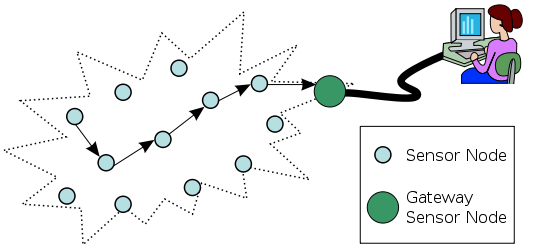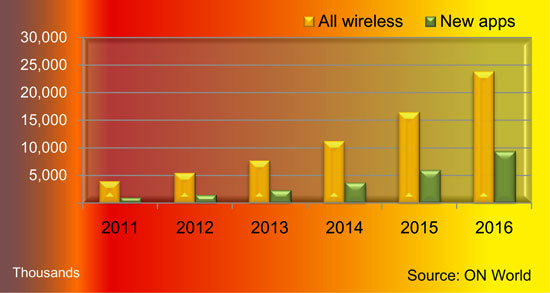Wireless sensor networks represent an innovative technology for measurement and control applications. The deletion of lead wires provides high cost savings and an improved reliability for many long term monitoring applications.

Wireless Sensor Networks
Wireless sensor networks enable new capabilities for measurement and control applications. The reason for that is the wireless sensor data communication itself.
Wireless sensor networks make able long-term data transmission at scales and resolutions that are hard to obtain with old fashioned technologies.
Wireless sensor networks consist of a large number of small sensor nodes with high resolution sensing, computation and a wide range of wireless communication capabilities.

Applications
Process Management: In area monitoring, the Wireless Sensor Network is deployed over a region where some phenomenon is to be monitored. A military example is the use of wireless sensors in order to detect the intrusion of the enemy; a civilian example is the geo-fencing of gas or oil pipelines.
Health care: Wireless Sensor Network can be of two types: wearable and implanted. Wearable Wireless Sensors are used on the body surface of a human or just at close proximity of the user. The implantable medical Wireless Sensors are inserted inside human body. Body-area networks can collect information about an individual’s health, fitness and energy expenditure. There are many other applications.
Environmental/Earth: There are many applications in monitoring environmental parameters. Some examples are given below. They share the great challenges of harsh environments where the power supply is reduced.
Air pollution monitoring: Wireless sensor networks have been deployed in several cities (Stockholm and London for example) to monitor the concentration of dangerous gases for citizens. These can take advantage of the ad hoc wireless links rather than wired installations, which also make them more mobile for testing readings in different areas.
Forest fire detection: A Wireless Sensor network can be installed in a forest to detect when a fire has started. The nodes can be equipped with sensors to measure temperature, humidity and gases which are produced by fire in the trees or vegetation. The early detection is crucial for a successful action of the firefighters.
Landslide detection: A landslide detection system makes use of a wireless sensor network to detect the slight movements of soil and changes in various parameters that may occur before or during a landslide. Through the data gathered it may be possible to know the occurrence of landslides long before it actually happens.
Water quality monitoring: Water quality monitoring involves analyzing water properties in rivers, lakes or oceans, as well as underground water reserves. The use of many wireless sensors enables the creation of a more accurate map of the water status, and allows the permanent deployment of monitoring stations in locations of difficult access.
Natural disaster prevention: Wireless sensor networks can effectively act to prevent the consequences of natural disasters, like floods and eruptions. Wireless nodes have successfully been deployed in rivers where changes of the water levels have to be monitored in real time.
Monitoring of Industrial Machine: Wireless sensor networks have been developed for machinery condition-based maintenance as they offer significant cost savings and enable new functions and applications.
Data logging: Wireless sensor networks are also used for the collection of data for monitoring of environmental information, this can be as simple as the monitoring of the temperature or humidity in a fridge to the level of water in overflow tanks in nuclear power plants. The statistical information can then be used to show how systems have been working. The advantage of Wireless Sensor Networks over conventional loggers is the “live” data.
Water/Waste monitoring: The monitoring of the quality and level of water includes many activities such as checking the quality of underground or surface water, and ensuring a country’s water infrastructure for the benefit of both human and animal. It may be used against the wastage of water.
Structural/Building Monitoring: Wireless sensor networks can be used to monitor the condition of civil infrastructure/buildings and related geo-physical processes close to real time, and over long periods.
